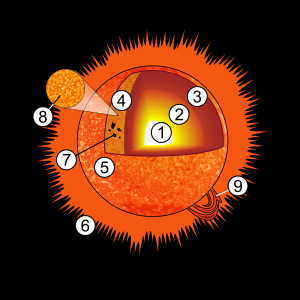The core of the Sun is considered to extend from the center to about 0.2 to 0.25 solar radii.[31] It has a density of up to 150 g/cm3[32][33] (150 times the density of water at standard

1. Core
2. Radiative zone
3. Convective zone
4. Photosphere
5. Chromosphere
6. Corona
7. Sunspot
8. Granules
9. Prominence
temperature and pressure) and a temperature of close to 13,600,000 kelvins (by contrast, the surface of the Sun is around 5,800 kelvins). Recent analysis of SOHO mission data favors a faster rotation rate in the core than in the rest of the radiative zone.[31] Through most of the Sun's life, energy is produced by nuclear fusion through a series of steps called the p–p (proton–proton) chain; this process converts hydrogen into helium.[34] Less than 2% of the helium generated in the Sun comes from the CNO cycle.
The core is the only location in the Sun that produces an appreciable amount of heat through fusion; inside 24% of the Sun's radius, 99% of the power has been generated, and by 30% of the radius, fusion has stopped nearly entirely. The rest of the star is heated by energy that is transferred outward from the core and the layers just outside. The energy produced by fusion in the core must then travel through many successive layers to the solar photosphere before it escapes into space as sunlight or kinetic energy of particles.[35][36]
The proton-proton chain occurs around 9.2 × 1037 times each second in the core of the Sun. Since this reaction uses four protons, it converts about 3.7 × 1038 protons (hydrogen nuclei) to helium nuclei every second (out of a total of ~8.9 × 1056 free protons in the Sun), or about 6.2 × 1011 kg per second.[36] Since fusing hydrogen into helium releases around 0.7% of the fused mass as energy,[37] the Sun releases energy at the mass-energy conversion rate of 4.26 million metric tons per second, 383 yottawatts (3.83×1026 W),[36] or 9.15 × 1010 megatons of TNT per second. This mass is not destroyed to create the energy, rather, the mass is carried away in the radiated energy, as described by the concept of mass-energy equivalence.
The energy production per unit time (power) produced by fusion in the core varies with distance from the solar center. At the center of the sun, fusion power is estimated by model to be about 276.5 watts/m3,[38] a power production density which more nearly approximates reptile

metabolism than a thermonuclear bomb.[39] Peak power production in the Sun has been compared to the volumetric heats generated in an active compost heap. The tremendous power output of the Sun is not due to its high power per volume, but instead due to its large size.
The fusion rate in the core is in a self-correcting equilibrium: a slightly higher rate of fusion would cause the core to heat up more and expand slightly against the weight of the outer layers, reducing the fusion rate and correcting the perturbation; and a slightly lower rate would cause the core to cool and shrink slightly, increasing the fusion rate and again reverting it to its present level.[40][41]
The high-energy photons (gamma rays) released in fusion reactions are absorbed in only a few millimeters of solar plasma and then re-emitted again in random direction (and at slightly lower energy)—so it takes a long time for radiation to reach the Sun's surface. Estimates of the "photon travel time" range between 10,000 and 170,000 years.[42]
After a final trip through the convective outer layer to the transparent "surface" of the photosphere, the photons escape as visible light. Each gamma ray in the Sun's core is converted into several million visible light photons before escaping into space. Neutrinos are also released by the fusion reactions in the core, but unlike photons they rarely interact with matter, so almost all are able to escape the Sun immediately. For many years measurements of the number of neutrinos produced in the Sun were lower than theories predicted by a factor of 3. This discrepancy was recently resolved through the discovery of the effects of neutrino oscillation: the Sun emits the number of neutrinos predicted by the theory, but neutrino detectors were missing 2⁄3 of them because the neutrinos had changed flavor


0 comments:
Post a Comment